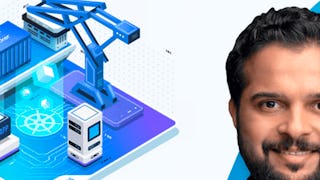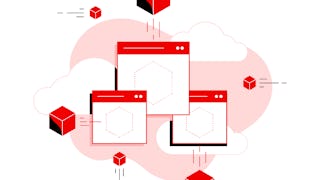Passez à l'étape suivante de votre carrière d'ingénieur logiciel en vous familiarisant avec les outils et les technologies de conteneurisation ! Le salaire moyen pour les emplois nécessitant des compétences en matière de conteneurs est de 137 000 $ aux États-Unis selon salary.com, ce qui fait que les professionnels Devops et les développeurs dotés de ces compétences sont très demandés. Plus de 70 % des entreprises du classement Fortune 100 utilisent des applications conteneurisées. Mais pourquoi ?

Fin demain. Donnez un coup de fouet à votre carrière en bénéficiant de 40 % de réduction sur les cours d'Adobe, d'IBM et d'autres. Économisez maintenant.


Introduction aux conteneurs avec Docker, Kubernetes et OpenShift
Ce cours fait partie de plusieurs programmes.
Enseigné en Français (doublage IA)


Instructeurs : Alex Parker
133 466 déjà inscrits
Inclus avec 
(977 avis)
Expérience recommandée
Ce que vous apprendrez
Grâce aux conteneurs, apprenez à déplacer rapidement des applications dans n'importe quel environnement.
Créez des applications cloud natives en utilisant Docker, Kubernetes, OpenShift et Istio.
Décrire et exploiter l'architecture Kubernetes pour mettre en place et utiliser un système de gestion de conteneurs basé sur le cycle de vie complet.
Créez et exploitez un fichier de déploiement YAML pour configurer et créer des ressources telles que des pods, des services, des ensembles de réplicas et autres d'une manière déclarative.
Compétences que vous acquerrez
- Catégorie : DevOps
- Catégorie : YAML
- Catégorie : Cloud Native Computing
- Catégorie : Interface de ligne de commande
- Catégorie : Docker (Logiciel)
- Catégorie : Microservices
- Catégorie : Kubernetes
- Catégorie : Istio
- Catégorie : CI/CD
- Catégorie : Conteneurisation
- Catégorie : OpenShift
- Catégorie : Évolutivité
- Catégorie : Virtualisation
- Catégorie : Déploiement des applications
Détails à connaître

Ajouter à votre profil LinkedIn
8 devoirs
Découvrez comment les employés des entreprises prestigieuses maîtrisent des compétences recherchées

Élaborez votre expertise du sujet
- Apprenez de nouveaux concepts auprès d'experts du secteur
- Acquérez une compréhension de base d'un sujet ou d'un outil
- Développez des compétences professionnelles avec des projets pratiques
- Obtenez un certificat professionnel partageable auprès de IBM

Il y a 5 modules dans ce cours
Commencez votre première semaine en découvrant les concepts, les caractéristiques, les cas d'utilisation et les avantages des conteneurs. En vous appuyant sur vos nouvelles connaissances des conteneurs, vous apprendrez ce que fait Docker et découvrirez pourquoi Docker est une solution gagnante pour les développeurs. Vous apprendrez ce qu'est Docker, vous vous familiariserez avec les processus Docker et vous explorerez la technologie sous-jacente de Docker. Découvrez comment les développeurs et les organisations peuvent tirer profit de l'utilisation de Docker et quelles sont les situations où l'utilisation de Docker est difficile. Ensuite, vous apprendrez à construire une image de conteneur à l'aide d'un fichier Docker, à créer un conteneur en cours d'exécution à l'aide de cette image, à vous familiariser avec l'interface de ligne de commande (CLI) de Docker et à explorer les commandes Docker les plus fréquemment utilisées. Vous vous familiariserez avec les objets Docker, les commandes Dockerfile, le nommage des images de conteneurs et apprendrez comment Docker utilise les réseaux, le stockage et les plugins. Ensuite, vous assimilerez ces connaissances en voyant les composants de l'architecture Docker en action et en explorant la conteneurisation à l'aide de Docker. À la fin de cette première semaine, vous tirerez une image d'un registre Docker Hub. Vous exécuterez une image en tant que conteneur à l'aide de Docker, construirez et marquerez une image à l'aide d'un Dockerfile, et pousserez cette image vers un registre.
Inclus
6 vidéos2 lectures2 devoirs2 éléments d'application4 plugins
Au cours de la deuxième semaine, découvrez ce qu'est l'orchestration de conteneurs. Ensuite, découvrez comment les développeurs peuvent utiliser l'orchestration de conteneurs pour créer et gérer des cycles de développement d'environnements de conteneurs complexes. Kubernetes est actuellement la plateforme d'orchestration de conteneurs la plus populaire. Vous examinerez les principaux composants architecturaux de Kubernetes, notamment les composants du plan de contrôle et les contrôleurs. Vous explorerez les objets Kubernetes et apprendrez comment fonctionnent des objets Kubernetes spécifiques tels que les Pods, les ReplicaSets et les Deployments. Ensuite, vous apprendrez comment les développeurs utilisent l'interface de ligne de commande (CLI) de Kubernetes, ou "kubectl", pour manipuler les objets, gérer les charges de travail dans un cluster Kubernetes et appliquer les commandes kubectl de base. Vous serez en mesure de différencier les avantages et les inconvénients de l'utilisation de commandes impératives et déclaratives. À la fin de ce module, vous utiliserez les commandes CLI kubectl pour créer des ressources sur un cluster Kubernetes réel. À la fin de cette semaine, vous utiliserez le CLI Kubernetes pour créer un pod Kubernetes, créer un déploiement Kubernetes, créer un ReplicaSet et voir l'équilibrage de charge Kubernetes en action.
Inclus
6 vidéos1 lecture2 devoirs2 éléments d'application4 plugins
Au cours de la troisième semaine, vous explorerez les ReplicaSets, l'autoscaling, les rolling updates, les ConfigMaps, les Secrets et les bindings de service, et apprendrez comment vous pouvez utiliser ces capacités pour gérer les applications Kubernetes. Vous apprendrez comment les ReplicaSets mettent à l'échelle les applications pour répondre à une demande croissante, et comment l'autoscaling crée une mise à l'échelle dynamique basée sur la demande. Vous verrez comment utiliser les rolling updates pour publier des mises à jour d'applications et revenir en arrière sans interrompre l'expérience utilisateur. Vous apprendrez à utiliser les ConfigMaps et les Secrets pour fournir des variables de configuration et des informations sensibles à vos déploiements et pour garder votre code propre. À la fin de la semaine, vous mettrez à l'échelle et mettrez à jour des applications déployées dans Kubernetes.
Inclus
5 vidéos2 lectures2 devoirs2 éléments d'application3 plugins
Au cours de la quatrième semaine, vous en apprendrez davantage sur l'écosystème croissant de Kubernetes et explorerez d'autres outils qui fonctionnent bien avec Kubernetes pour soutenir le développement cloud-natif. Vous comprendrez les similitudes et les différences entre Red Hat ® OpenShift® et Kubernetes et verrez à quoi ressemble l'architecture OpenShift. Vous découvrirez les builds et BuildConfigs d'OpenShift, ainsi que les stratégies de build et les déclencheurs d'OpenShift. Vous découvrirez également comment les opérateurs peuvent déployer facilement des applications entières. Enfin, vous examinerez comment le maillage de services Istio gère et sécurise le trafic et la communication entre les services d'une application. À la fin de la semaine, vous utiliserez le CLI oc pour exécuter des commandes sur un cluster OpenShift. Et vous utiliserez les capacités de construction d'OpenShift pour déployer une application à partir d'un code source stocké dans un dépôt Git.
Inclus
4 vidéos1 lecture2 devoirs1 élément d'application3 plugins
Pour le projet final, vous allez mettre en pratique les outils et les concepts appris dans ce cours, et déployer une application simple de livre d'or avec Docker et Kubernetes. L'application entière sera déployée et gérée sur OpenShift.
Inclus
3 lectures1 évaluation par les pairs3 éléments d'application3 plugins
Obtenez un certificat professionnel
Ajoutez ce titre à votre profil LinkedIn, à votre curriculum vitae ou à votre CV. Partagez-le sur les médias sociaux et dans votre évaluation des performances.
Instructeurs


Offert par
En savoir plus sur Cloud Computing
 Statut : Essai gratuit
Statut : Essai gratuit
KodeKloud
 Statut : Essai gratuit
Statut : Essai gratuit
Pour quelles raisons les étudiants sur Coursera nous choisissent-ils pour leur carrière ?




Avis des étudiants
977 avis
- 5 stars
66,32 %
- 4 stars
19,38 %
- 3 stars
5 %
- 2 stars
4,89 %
- 1 star
4,38 %
Affichage de 3 sur 977
Révisé le 19 oct. 2021
I audited this course, but it was pretty much what I hoped for. Nice hands on exercises that are the core of a good training course for me.
Révisé le 22 juin 2021
Very good introduction to the basic concepts of Containerization and Kubernetes. Good examples to get a starting feel on how to work with such tools
Révisé le 7 nov. 2023
Very happy to attend and complete this course. Where it's possible to see the effort and dedication behind it. Highly recommended

Ouvrez de nouvelles portes avec Coursera Plus
Accès illimité à 10,000+ cours de niveau international, projets pratiques et programmes de certification prêts à l'emploi - tous inclus dans votre abonnement.
Faites progresser votre carrière avec un diplôme en ligne
Obtenez un diplôme auprès d’universités de renommée mondiale - 100 % en ligne
Rejoignez plus de 3 400 entreprises mondiales qui ont choisi Coursera pour les affaires
Améliorez les compétences de vos employés pour exceller dans l’économie numérique
Foire Aux Questions
ce cours n'a pas de prérequis rigides, mais nous vous recommandons d'avoir suivi le cours "Introduction à l'informatique en nuage" et de posséder les compétences suivantes : - Informatique de base et compréhension des concepts de base de l'informatique dématérialisée - Compréhension de la ligne de commande et des commandes shell
Nous vous recommandons de suivre le cours "Introduction à l'informatique dématérialisée" avant de suivre cette formation.
L'accès aux cours et aux devoirs dépend de votre type d'inscription. Si vous suivez un cours en mode audit, vous pourrez consulter gratuitement la plupart des supports de cours. Pour accéder aux devoirs notés et obtenir un certificat, vous devrez acheter l'expérience de certificat, pendant ou après votre audit. Si vous ne voyez pas l'option d'audit :
Il se peut que le cours ne propose pas d'option d'audit. Vous pouvez essayer un essai gratuit ou demander une aide financière.
Le cours peut proposer l'option "Cours complet, pas de certificat" à la place. Cette option vous permet de consulter tous les supports de cours, de soumettre les évaluations requises et d'obtenir une note finale. Cela signifie également que vous ne pourrez pas acheter un certificat d'expérience.
Plus de questions
Aide financière disponible,




